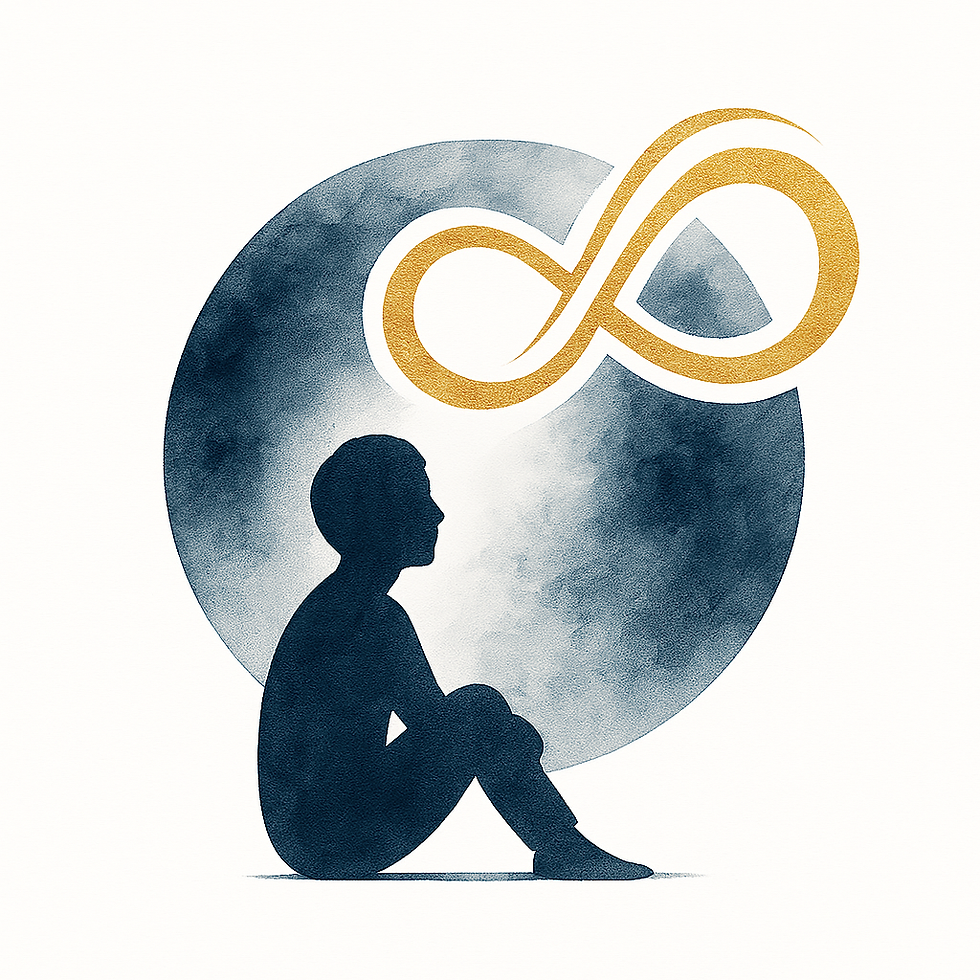How to Work with Your Pelvis After a C-Section?
- Marta

- May 26
- 6 min read
I stood in front of the bathroom mirror, seven months after my cesarean section, and didn't recognize my reflection. It wasn't about the weight or stretch marks. It was about looking at my body and feeling: "This isn't me." My hips felt out of place, constant tension in my lower back, pulling here, aching there, a strange feeling in my pelvis like something was "hanging" there.

The gynecologist at my check-up said everything was healing properly. Nothing more interested him, nothing new. He stated it was normal after childbirth. "It will even out," I heard. "Your body needs time." But I felt something wasn't right. And I was tired of waiting for it to "just pass."
I met Zuzanna by chance - a friend recommended her when I complained about back pain. "Go to her, she really knows what she's doing with women after childbirth," she said. It was my first visit to a gynecological physiotherapist who didn't just ask about pain, but about the whole story - how my pregnancy went, the birth, how I feel in my body now.
After that consultation, I knew I'd found the right person. Zuza not only knew anatomy but understood what I was going through psychologically. When I recently came across her workshop announcement "Pelvis at Rest," I didn't hesitate for a moment.
I signed up. Small group. Perfect - larger groups always intimidate me, especially when I have to talk about such intimate problems.
Saturday Morning
Andersa 3/17 in Sopot is a small building near the center. LEKKO zone is located on the ground floor - bright rooms, minimalist decor, friendly and calm atmosphere. From the entrance, you can feel this is a place where you can relax.
I arrived a moment before, as Zuza advised. Inside, three other participants were already waiting. When I used to think about physiotherapists, I pictured white outfits and exercises rather than open conversations. Sporty attire, hair tied in a practical bun, a smile that immediately builds trust. "Hello, girls. Before we start, tell me briefly what brought you here." Zuza knows how to take care of her patients.
Each spoke in turn. Back pain, stomach problems, "something's not right with my pelvis," urinary urgency while running, painful periods. Listening to others, I thought: "Oh God, it's not just me."
Zuza listened carefully, asked questions. It wasn't mechanical questioning, but a real conversation. "How do you feel in your body now?" she asked at one point. The question hit home.
Anatomy Lesson
We spent the first part with anatomical models. Zuza showed how our pelvis really looks, where the pelvic floor muscles are, how they work with the diaphragm and abdominal muscles.
"Look," she said, pointing to the model, "this isn't one muscle, but an entire system. Like a hammock stretched between the pelvic bones. And this hammock must work with the diaphragm, with the abdominal muscles, with the back."
Finally, someone explained to me why when I'm stressed, my stomach hurts first, then my back, and finally I feel discomfort "down there." These weren't separate problems - it was one system that had stopped working together.
"After childbirth, especially after a cesarean section, all these structures must learn to cooperate again. It's like a band that hasn't played together for months. Each instrument remembers its part, but they need to be synchronized."
Then came time for practice. We spread mats on the floor. "Now I'll check how your team works during breathing," Zuza said. She placed one hand on my ribs, another on my lower back. She checked if my diaphragm was working properly. Now it's okay, but it's a matter of exercises, yoga, and breathing work I've been doing for 2 years. It wasn't so rosy before.
Exercises That Seem Simple
For the next hour, we did exercises. At first glance, they looked ridiculously simple - lying, breathing, gentle tensing and relaxing. But the devil was in the details.
"Now, when you exhale, gently pull your pelvic floor muscles, as if you wanted to stop a droplet." The first attempts were difficult. Either I did it too hard, or I couldn't feel what was happening "down there" at all. The effort was jerky and irregular. But Zuza was patient. "This is normal. These muscles were weakened by pregnancy and childbirth. Now they're learning again."
After fifteen minutes of exercises, I felt something I hadn't felt for months - connection with my own pelvis. As if this part of my body suddenly started "talking" to me.
During the break, we sat with tea. That's when the real confessions about women's bodies began, because who else understands like another woman.
"And I have PMS like from a nightmare," added a colleague. "Before my period, I become a monster. Everything hurts, I'm aggressive, my husband doesn't know what to do with me anymore."
Listening to their stories, I felt relief. Finally, I wasn't alone with these problems. In a normal situation, I would never talk about such things with strange women, but here we naturally opened up.
"This is the effect of hormonal system disorders, but also the impact of stress on body tension. The pelvis is an area where a lot of emotions accumulate. When it's tense, it affects the entire body."
Effects You Can Feel Right Away
The second part of the workshop was more practice. Zuza showed each of us how to apply exercises to specific problems. Focus on coordinating breath with diaphragm work.
After an hour of exercises, I felt different. Hard to describe - as if my body was more "whole," more connected with itself. The back pain that had been with me since morning disappeared.
"It's not magic. It's simply the effect of your body starting to work together. Muscles relaxed, tension decreased."
I have this feeling about body work that effects come relatively quickly, especially in the pelvic area. The real challenge is consistency - will I remember these exercises at home, in daily rushing.
Support for Home Work
At the end, Zuza sent each of us files with exercises tailored to our needs. These weren't generic instructions from the internet, but specific guidelines - how many times a day, in what situations, what to pay attention to.
"Remember, this is a process. Don't expect everything to be perfect after one week. But if you do these exercises regularly, you'll feel a difference in a month."
We exchanged phone numbers with other participants. "We can support each other," said one of them. "Remind each other about exercises, share how we're doing."
On the way home, I felt lighter. Not just physically - psychologically too. For the first time in a long while, I felt I had influence over how my pelvis feels. That it's not that I have to accept discomfort, pain, problems after childbirth.
For the next few days, I religiously did the exercises. In the morning after waking up, during the day, before sleep. Most of them could be done unnoticed - while working at the computer, watching TV, or lying on the couch.
After a week, back pain significantly decreased. After two - I felt I had better control over my pelvis. After a month - that this was my body again.
Practical Information
If you're considering participating in "Pelvis at Rest" workshops, here's what's worth knowing:
They take place at LEKKO zone at Andersa 3/17 in Sopot, from 9:00 to 11:30. Zuza recommends arriving a few minutes early and having a light breakfast before the sessions.
Led by Zuzanna Kulczyńska (www.lekkostrefa.pl). The group has about 5 people - small enough for individual approach, large enough for group support.
Bring comfortable exercise clothes and an open mind. These aren't fitness classes - it's education and learning to listen to your body.
What Really Changed
Today, a few weeks after the workshop, I look in the mirror and see myself. My body is mine again. Not perfect, not like before pregnancy, but mine. I know how to care for it, how to respond to signals, how to help myself in difficult moments.
Have the problems completely disappeared? Not yet. But I have tools to deal with them. And most importantly - I know it's normal, that you can work on it, that I'm not alone.
This was a lesson not just in anatomy or physiotherapy. It was a lesson in reclaiming myself. And it was worth every penny, every minute spent on those mats in the Sopot office.
If you want to know yourself, really - without filters, order your personal Human Design report. I'll prepare it for you to be your personal user manual and life support.
Remember, the most important thing is your intuition and what your body feels. Observe facts. Question imposed limitations. Your body doesn't lie, and intuition sees truth that experts sometimes miss.
All content is my subjective opinion, based on my experiences and feelings. The only person who knows what's good for you - is you!
_edited.png)


